Environmental Impact Assessment and Soft Tools
VerifiedAdded on 2023/01/23
|14
|3941
|71
AI Summary
This document discusses the key learnings of limit to growth and how countries are tackling these issues. It also compares the steps for obtaining project approval in two states. The importance of public participation in Environmental Impact Assessment (EIA) is explored, along with the areas where public opinion should be sought. Lastly, an environmental impact assessment is conducted for a development activity in Australia.
Contribute Materials
Your contribution can guide someone’s learning journey. Share your
documents today.
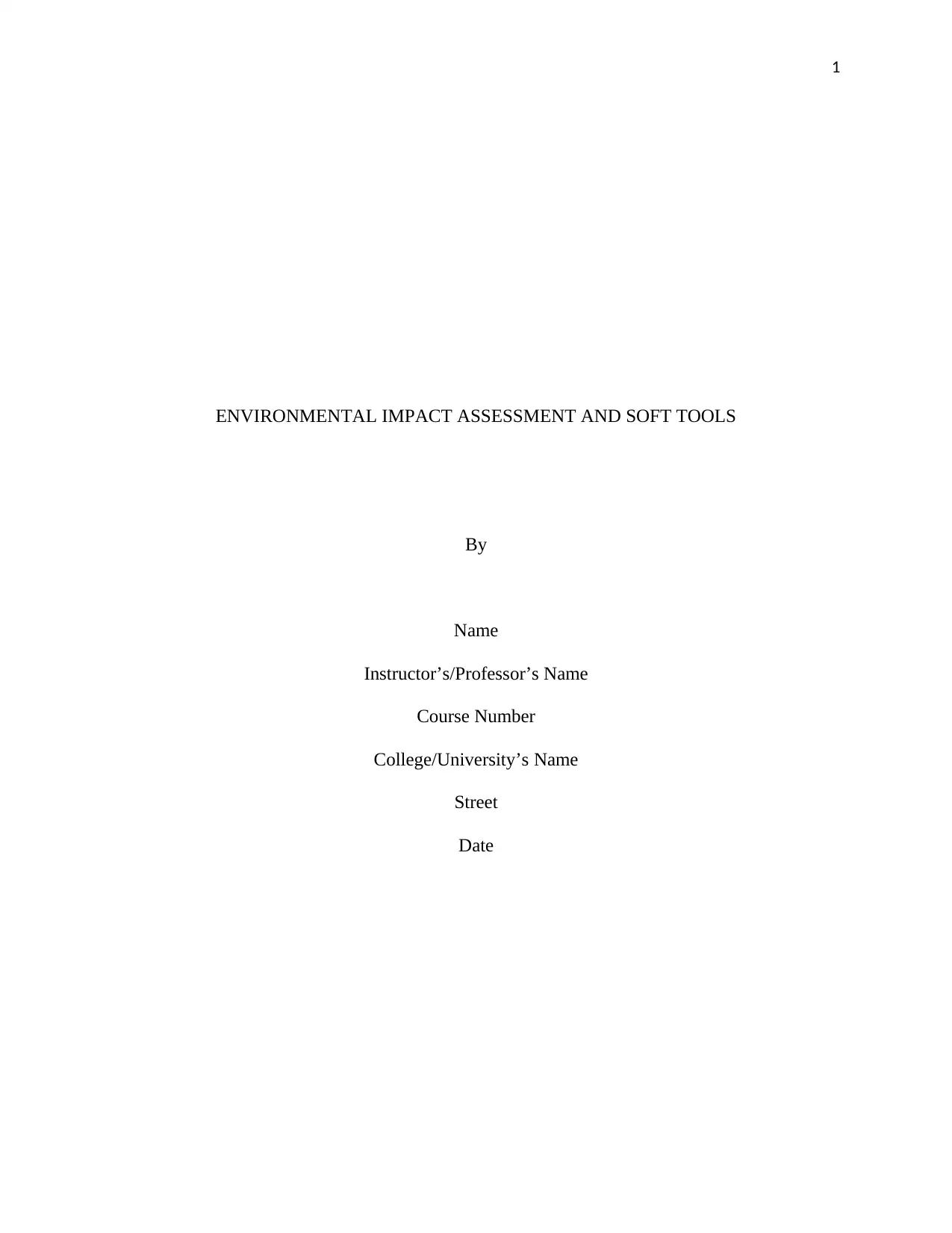
1
ENVIRONMENTAL IMPACT ASSESSMENT AND SOFT TOOLS
By
Name
Instructor’s/Professor’s Name
Course Number
College/University’s Name
Street
Date
ENVIRONMENTAL IMPACT ASSESSMENT AND SOFT TOOLS
By
Name
Instructor’s/Professor’s Name
Course Number
College/University’s Name
Street
Date
Secure Best Marks with AI Grader
Need help grading? Try our AI Grader for instant feedback on your assignments.
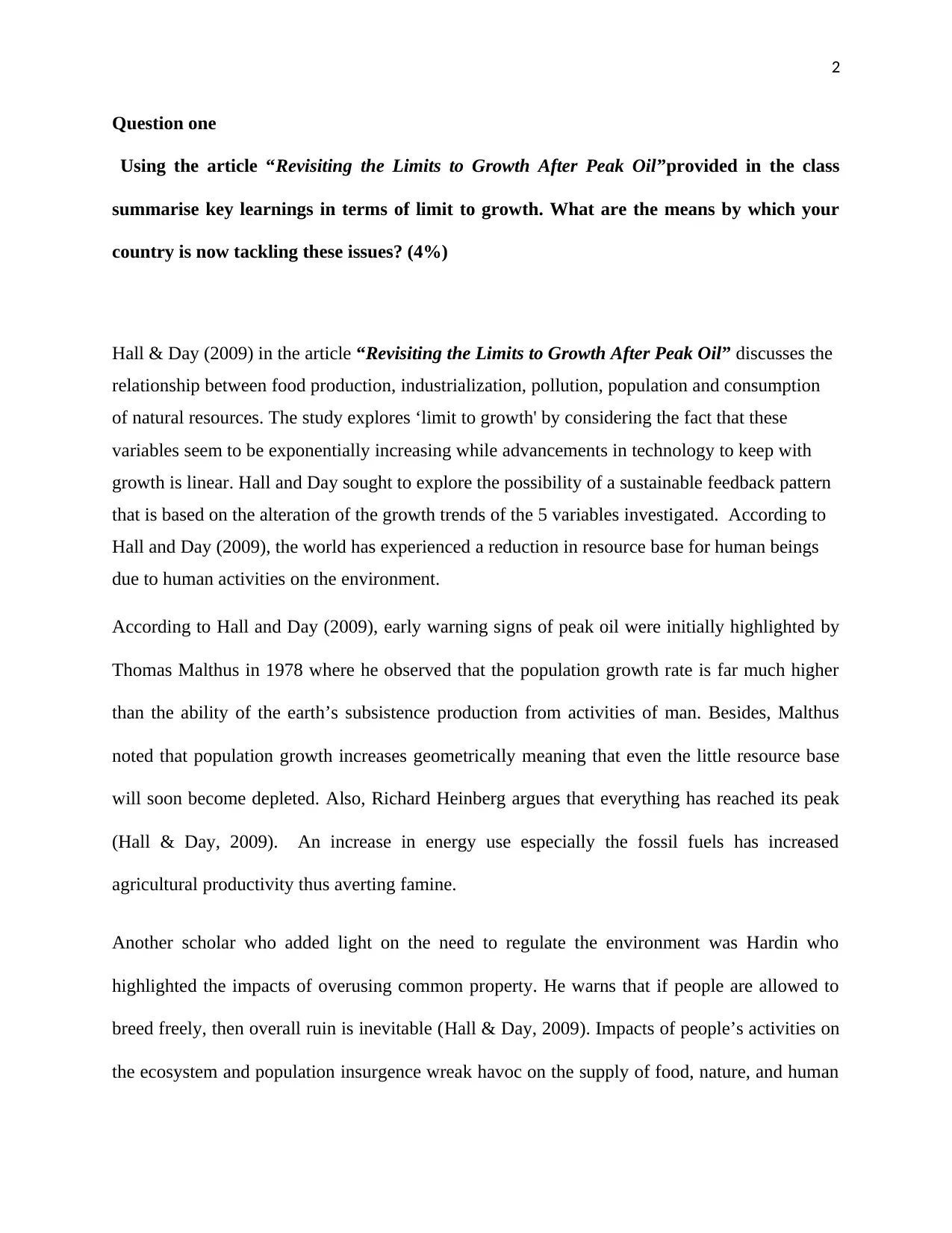
2
Question one
Using the article “Revisiting the Limits to Growth After Peak Oil”provided in the class
summarise key learnings in terms of limit to growth. What are the means by which your
country is now tackling these issues? (4%)
Hall & Day (2009) in the article “Revisiting the Limits to Growth After Peak Oil” discusses the
relationship between food production, industrialization, pollution, population and consumption
of natural resources. The study explores ‘limit to growth' by considering the fact that these
variables seem to be exponentially increasing while advancements in technology to keep with
growth is linear. Hall and Day sought to explore the possibility of a sustainable feedback pattern
that is based on the alteration of the growth trends of the 5 variables investigated. According to
Hall and Day (2009), the world has experienced a reduction in resource base for human beings
due to human activities on the environment.
According to Hall and Day (2009), early warning signs of peak oil were initially highlighted by
Thomas Malthus in 1978 where he observed that the population growth rate is far much higher
than the ability of the earth’s subsistence production from activities of man. Besides, Malthus
noted that population growth increases geometrically meaning that even the little resource base
will soon become depleted. Also, Richard Heinberg argues that everything has reached its peak
(Hall & Day, 2009). An increase in energy use especially the fossil fuels has increased
agricultural productivity thus averting famine.
Another scholar who added light on the need to regulate the environment was Hardin who
highlighted the impacts of overusing common property. He warns that if people are allowed to
breed freely, then overall ruin is inevitable (Hall & Day, 2009). Impacts of people’s activities on
the ecosystem and population insurgence wreak havoc on the supply of food, nature, and human
Question one
Using the article “Revisiting the Limits to Growth After Peak Oil”provided in the class
summarise key learnings in terms of limit to growth. What are the means by which your
country is now tackling these issues? (4%)
Hall & Day (2009) in the article “Revisiting the Limits to Growth After Peak Oil” discusses the
relationship between food production, industrialization, pollution, population and consumption
of natural resources. The study explores ‘limit to growth' by considering the fact that these
variables seem to be exponentially increasing while advancements in technology to keep with
growth is linear. Hall and Day sought to explore the possibility of a sustainable feedback pattern
that is based on the alteration of the growth trends of the 5 variables investigated. According to
Hall and Day (2009), the world has experienced a reduction in resource base for human beings
due to human activities on the environment.
According to Hall and Day (2009), early warning signs of peak oil were initially highlighted by
Thomas Malthus in 1978 where he observed that the population growth rate is far much higher
than the ability of the earth’s subsistence production from activities of man. Besides, Malthus
noted that population growth increases geometrically meaning that even the little resource base
will soon become depleted. Also, Richard Heinberg argues that everything has reached its peak
(Hall & Day, 2009). An increase in energy use especially the fossil fuels has increased
agricultural productivity thus averting famine.
Another scholar who added light on the need to regulate the environment was Hardin who
highlighted the impacts of overusing common property. He warns that if people are allowed to
breed freely, then overall ruin is inevitable (Hall & Day, 2009). Impacts of people’s activities on
the ecosystem and population insurgence wreak havoc on the supply of food, nature, and human
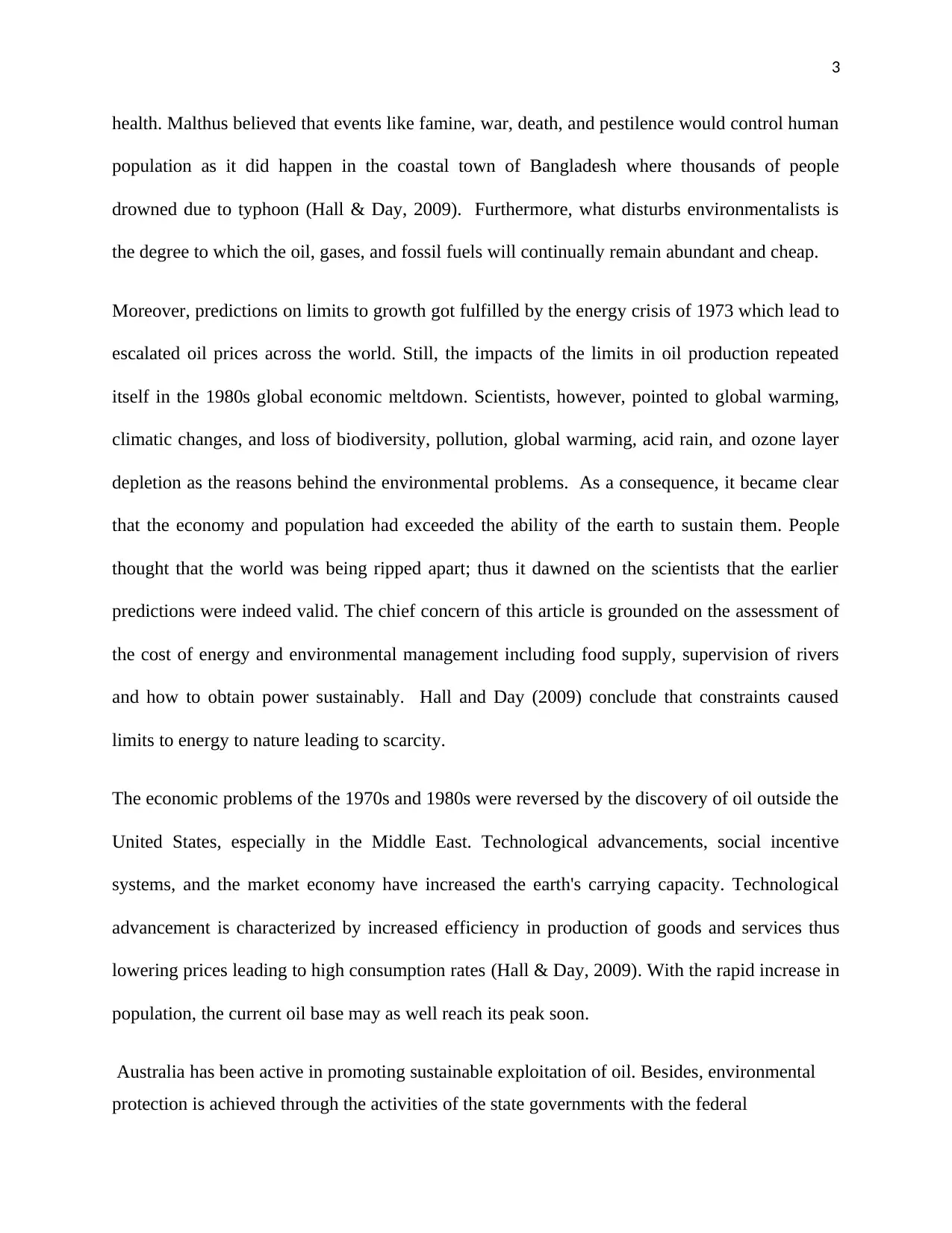
3
health. Malthus believed that events like famine, war, death, and pestilence would control human
population as it did happen in the coastal town of Bangladesh where thousands of people
drowned due to typhoon (Hall & Day, 2009). Furthermore, what disturbs environmentalists is
the degree to which the oil, gases, and fossil fuels will continually remain abundant and cheap.
Moreover, predictions on limits to growth got fulfilled by the energy crisis of 1973 which lead to
escalated oil prices across the world. Still, the impacts of the limits in oil production repeated
itself in the 1980s global economic meltdown. Scientists, however, pointed to global warming,
climatic changes, and loss of biodiversity, pollution, global warming, acid rain, and ozone layer
depletion as the reasons behind the environmental problems. As a consequence, it became clear
that the economy and population had exceeded the ability of the earth to sustain them. People
thought that the world was being ripped apart; thus it dawned on the scientists that the earlier
predictions were indeed valid. The chief concern of this article is grounded on the assessment of
the cost of energy and environmental management including food supply, supervision of rivers
and how to obtain power sustainably. Hall and Day (2009) conclude that constraints caused
limits to energy to nature leading to scarcity.
The economic problems of the 1970s and 1980s were reversed by the discovery of oil outside the
United States, especially in the Middle East. Technological advancements, social incentive
systems, and the market economy have increased the earth's carrying capacity. Technological
advancement is characterized by increased efficiency in production of goods and services thus
lowering prices leading to high consumption rates (Hall & Day, 2009). With the rapid increase in
population, the current oil base may as well reach its peak soon.
Australia has been active in promoting sustainable exploitation of oil. Besides, environmental
protection is achieved through the activities of the state governments with the federal
health. Malthus believed that events like famine, war, death, and pestilence would control human
population as it did happen in the coastal town of Bangladesh where thousands of people
drowned due to typhoon (Hall & Day, 2009). Furthermore, what disturbs environmentalists is
the degree to which the oil, gases, and fossil fuels will continually remain abundant and cheap.
Moreover, predictions on limits to growth got fulfilled by the energy crisis of 1973 which lead to
escalated oil prices across the world. Still, the impacts of the limits in oil production repeated
itself in the 1980s global economic meltdown. Scientists, however, pointed to global warming,
climatic changes, and loss of biodiversity, pollution, global warming, acid rain, and ozone layer
depletion as the reasons behind the environmental problems. As a consequence, it became clear
that the economy and population had exceeded the ability of the earth to sustain them. People
thought that the world was being ripped apart; thus it dawned on the scientists that the earlier
predictions were indeed valid. The chief concern of this article is grounded on the assessment of
the cost of energy and environmental management including food supply, supervision of rivers
and how to obtain power sustainably. Hall and Day (2009) conclude that constraints caused
limits to energy to nature leading to scarcity.
The economic problems of the 1970s and 1980s were reversed by the discovery of oil outside the
United States, especially in the Middle East. Technological advancements, social incentive
systems, and the market economy have increased the earth's carrying capacity. Technological
advancement is characterized by increased efficiency in production of goods and services thus
lowering prices leading to high consumption rates (Hall & Day, 2009). With the rapid increase in
population, the current oil base may as well reach its peak soon.
Australia has been active in promoting sustainable exploitation of oil. Besides, environmental
protection is achieved through the activities of the state governments with the federal
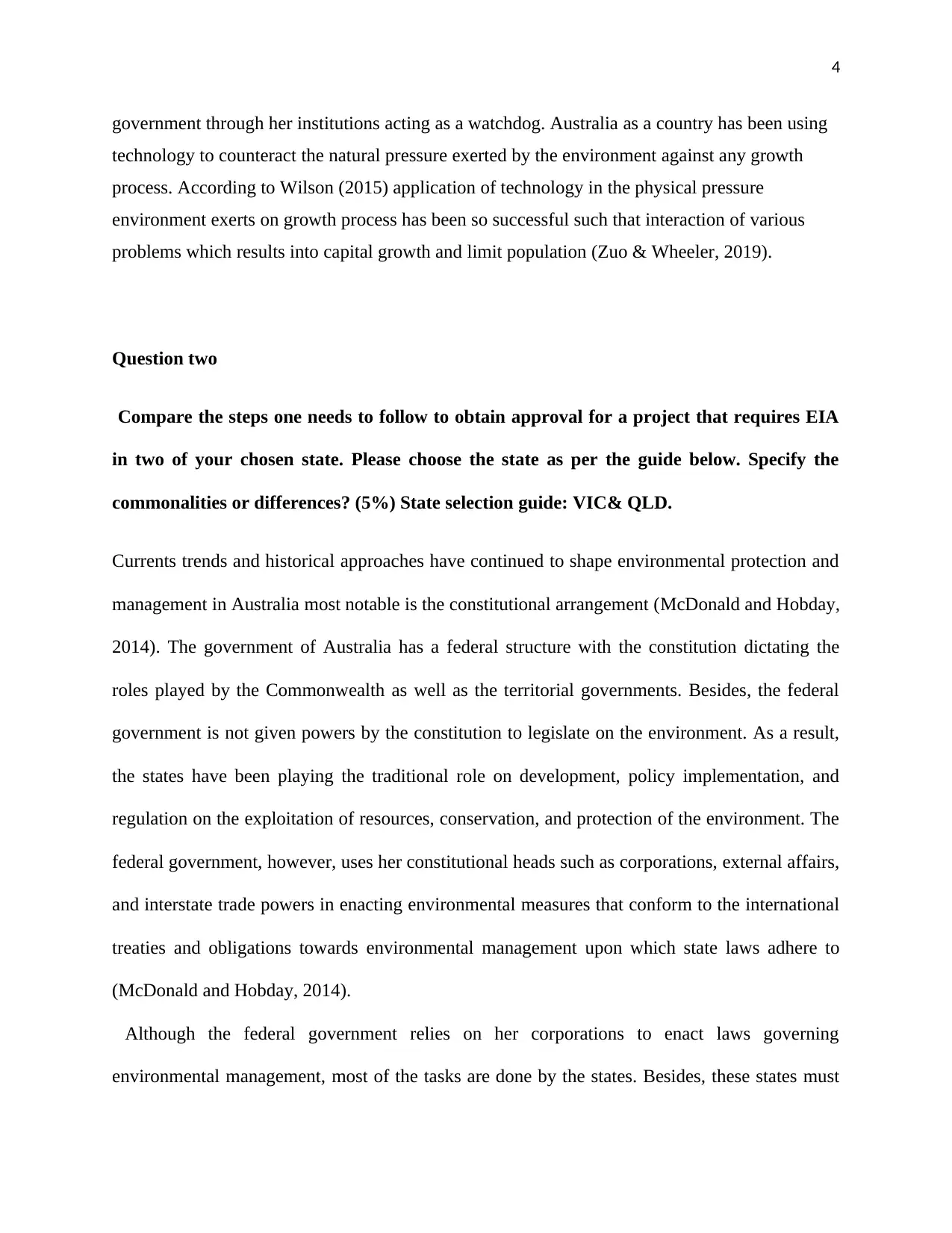
4
government through her institutions acting as a watchdog. Australia as a country has been using
technology to counteract the natural pressure exerted by the environment against any growth
process. According to Wilson (2015) application of technology in the physical pressure
environment exerts on growth process has been so successful such that interaction of various
problems which results into capital growth and limit population (Zuo & Wheeler, 2019).
Question two
Compare the steps one needs to follow to obtain approval for a project that requires EIA
in two of your chosen state. Please choose the state as per the guide below. Specify the
commonalities or differences? (5%) State selection guide: VIC& QLD.
Currents trends and historical approaches have continued to shape environmental protection and
management in Australia most notable is the constitutional arrangement (McDonald and Hobday,
2014). The government of Australia has a federal structure with the constitution dictating the
roles played by the Commonwealth as well as the territorial governments. Besides, the federal
government is not given powers by the constitution to legislate on the environment. As a result,
the states have been playing the traditional role on development, policy implementation, and
regulation on the exploitation of resources, conservation, and protection of the environment. The
federal government, however, uses her constitutional heads such as corporations, external affairs,
and interstate trade powers in enacting environmental measures that conform to the international
treaties and obligations towards environmental management upon which state laws adhere to
(McDonald and Hobday, 2014).
Although the federal government relies on her corporations to enact laws governing
environmental management, most of the tasks are done by the states. Besides, these states must
government through her institutions acting as a watchdog. Australia as a country has been using
technology to counteract the natural pressure exerted by the environment against any growth
process. According to Wilson (2015) application of technology in the physical pressure
environment exerts on growth process has been so successful such that interaction of various
problems which results into capital growth and limit population (Zuo & Wheeler, 2019).
Question two
Compare the steps one needs to follow to obtain approval for a project that requires EIA
in two of your chosen state. Please choose the state as per the guide below. Specify the
commonalities or differences? (5%) State selection guide: VIC& QLD.
Currents trends and historical approaches have continued to shape environmental protection and
management in Australia most notable is the constitutional arrangement (McDonald and Hobday,
2014). The government of Australia has a federal structure with the constitution dictating the
roles played by the Commonwealth as well as the territorial governments. Besides, the federal
government is not given powers by the constitution to legislate on the environment. As a result,
the states have been playing the traditional role on development, policy implementation, and
regulation on the exploitation of resources, conservation, and protection of the environment. The
federal government, however, uses her constitutional heads such as corporations, external affairs,
and interstate trade powers in enacting environmental measures that conform to the international
treaties and obligations towards environmental management upon which state laws adhere to
(McDonald and Hobday, 2014).
Although the federal government relies on her corporations to enact laws governing
environmental management, most of the tasks are done by the states. Besides, these states must
Secure Best Marks with AI Grader
Need help grading? Try our AI Grader for instant feedback on your assignments.
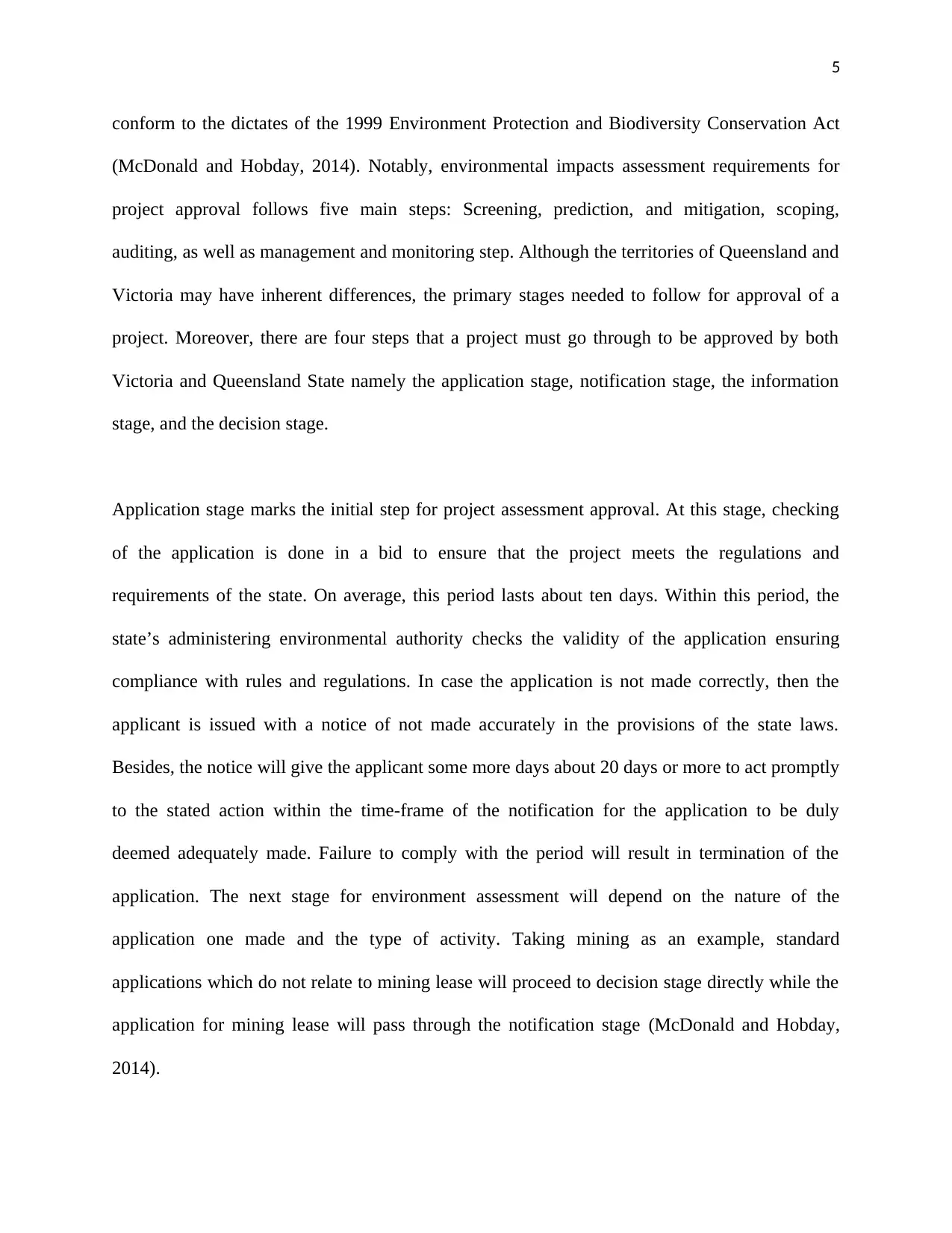
5
conform to the dictates of the 1999 Environment Protection and Biodiversity Conservation Act
(McDonald and Hobday, 2014). Notably, environmental impacts assessment requirements for
project approval follows five main steps: Screening, prediction, and mitigation, scoping,
auditing, as well as management and monitoring step. Although the territories of Queensland and
Victoria may have inherent differences, the primary stages needed to follow for approval of a
project. Moreover, there are four steps that a project must go through to be approved by both
Victoria and Queensland State namely the application stage, notification stage, the information
stage, and the decision stage.
Application stage marks the initial step for project assessment approval. At this stage, checking
of the application is done in a bid to ensure that the project meets the regulations and
requirements of the state. On average, this period lasts about ten days. Within this period, the
state’s administering environmental authority checks the validity of the application ensuring
compliance with rules and regulations. In case the application is not made correctly, then the
applicant is issued with a notice of not made accurately in the provisions of the state laws.
Besides, the notice will give the applicant some more days about 20 days or more to act promptly
to the stated action within the time-frame of the notification for the application to be duly
deemed adequately made. Failure to comply with the period will result in termination of the
application. The next stage for environment assessment will depend on the nature of the
application one made and the type of activity. Taking mining as an example, standard
applications which do not relate to mining lease will proceed to decision stage directly while the
application for mining lease will pass through the notification stage (McDonald and Hobday,
2014).
conform to the dictates of the 1999 Environment Protection and Biodiversity Conservation Act
(McDonald and Hobday, 2014). Notably, environmental impacts assessment requirements for
project approval follows five main steps: Screening, prediction, and mitigation, scoping,
auditing, as well as management and monitoring step. Although the territories of Queensland and
Victoria may have inherent differences, the primary stages needed to follow for approval of a
project. Moreover, there are four steps that a project must go through to be approved by both
Victoria and Queensland State namely the application stage, notification stage, the information
stage, and the decision stage.
Application stage marks the initial step for project assessment approval. At this stage, checking
of the application is done in a bid to ensure that the project meets the regulations and
requirements of the state. On average, this period lasts about ten days. Within this period, the
state’s administering environmental authority checks the validity of the application ensuring
compliance with rules and regulations. In case the application is not made correctly, then the
applicant is issued with a notice of not made accurately in the provisions of the state laws.
Besides, the notice will give the applicant some more days about 20 days or more to act promptly
to the stated action within the time-frame of the notification for the application to be duly
deemed adequately made. Failure to comply with the period will result in termination of the
application. The next stage for environment assessment will depend on the nature of the
application one made and the type of activity. Taking mining as an example, standard
applications which do not relate to mining lease will proceed to decision stage directly while the
application for mining lease will pass through the notification stage (McDonald and Hobday,
2014).
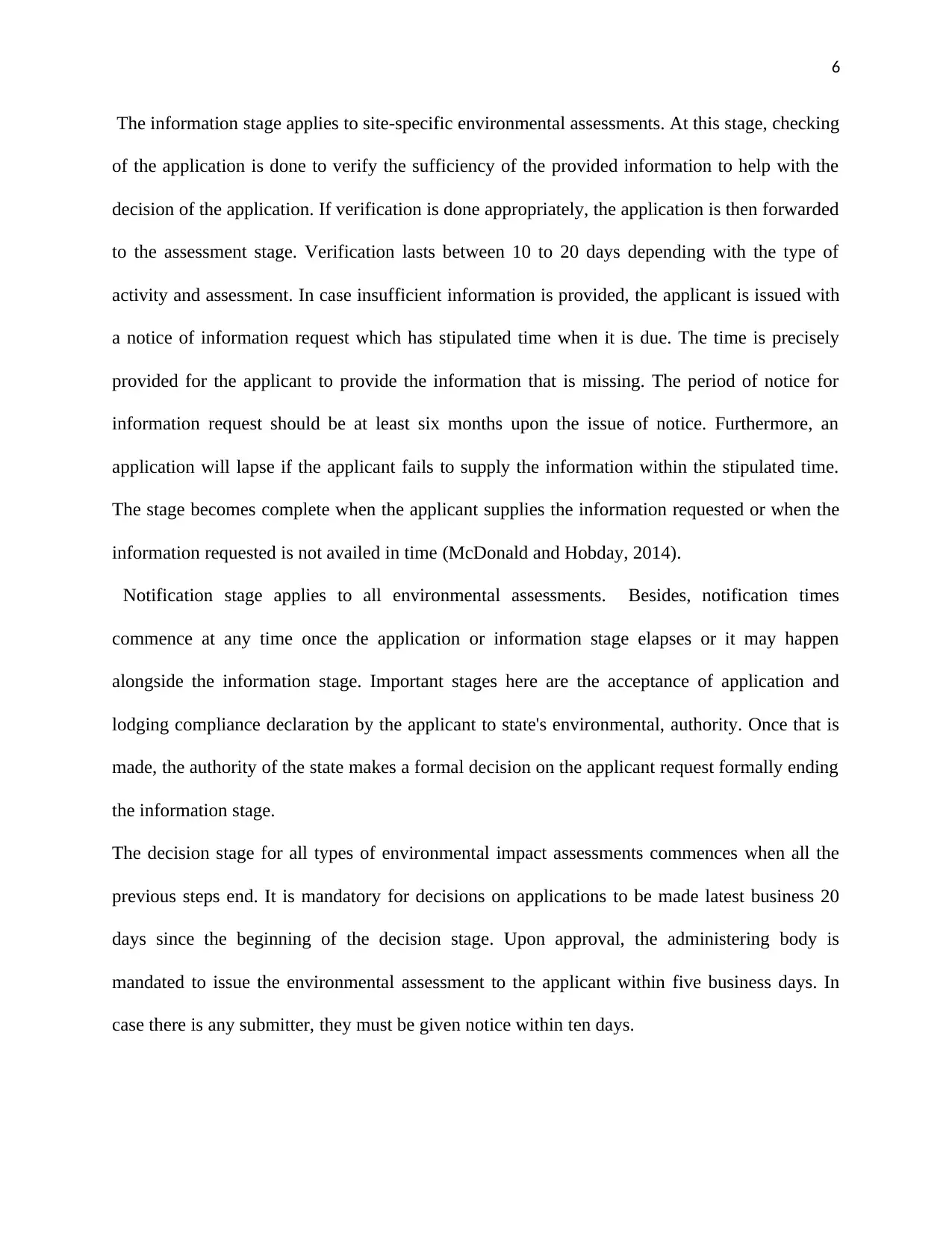
6
The information stage applies to site-specific environmental assessments. At this stage, checking
of the application is done to verify the sufficiency of the provided information to help with the
decision of the application. If verification is done appropriately, the application is then forwarded
to the assessment stage. Verification lasts between 10 to 20 days depending with the type of
activity and assessment. In case insufficient information is provided, the applicant is issued with
a notice of information request which has stipulated time when it is due. The time is precisely
provided for the applicant to provide the information that is missing. The period of notice for
information request should be at least six months upon the issue of notice. Furthermore, an
application will lapse if the applicant fails to supply the information within the stipulated time.
The stage becomes complete when the applicant supplies the information requested or when the
information requested is not availed in time (McDonald and Hobday, 2014).
Notification stage applies to all environmental assessments. Besides, notification times
commence at any time once the application or information stage elapses or it may happen
alongside the information stage. Important stages here are the acceptance of application and
lodging compliance declaration by the applicant to state's environmental, authority. Once that is
made, the authority of the state makes a formal decision on the applicant request formally ending
the information stage.
The decision stage for all types of environmental impact assessments commences when all the
previous steps end. It is mandatory for decisions on applications to be made latest business 20
days since the beginning of the decision stage. Upon approval, the administering body is
mandated to issue the environmental assessment to the applicant within five business days. In
case there is any submitter, they must be given notice within ten days.
The information stage applies to site-specific environmental assessments. At this stage, checking
of the application is done to verify the sufficiency of the provided information to help with the
decision of the application. If verification is done appropriately, the application is then forwarded
to the assessment stage. Verification lasts between 10 to 20 days depending with the type of
activity and assessment. In case insufficient information is provided, the applicant is issued with
a notice of information request which has stipulated time when it is due. The time is precisely
provided for the applicant to provide the information that is missing. The period of notice for
information request should be at least six months upon the issue of notice. Furthermore, an
application will lapse if the applicant fails to supply the information within the stipulated time.
The stage becomes complete when the applicant supplies the information requested or when the
information requested is not availed in time (McDonald and Hobday, 2014).
Notification stage applies to all environmental assessments. Besides, notification times
commence at any time once the application or information stage elapses or it may happen
alongside the information stage. Important stages here are the acceptance of application and
lodging compliance declaration by the applicant to state's environmental, authority. Once that is
made, the authority of the state makes a formal decision on the applicant request formally ending
the information stage.
The decision stage for all types of environmental impact assessments commences when all the
previous steps end. It is mandatory for decisions on applications to be made latest business 20
days since the beginning of the decision stage. Upon approval, the administering body is
mandated to issue the environmental assessment to the applicant within five business days. In
case there is any submitter, they must be given notice within ten days.
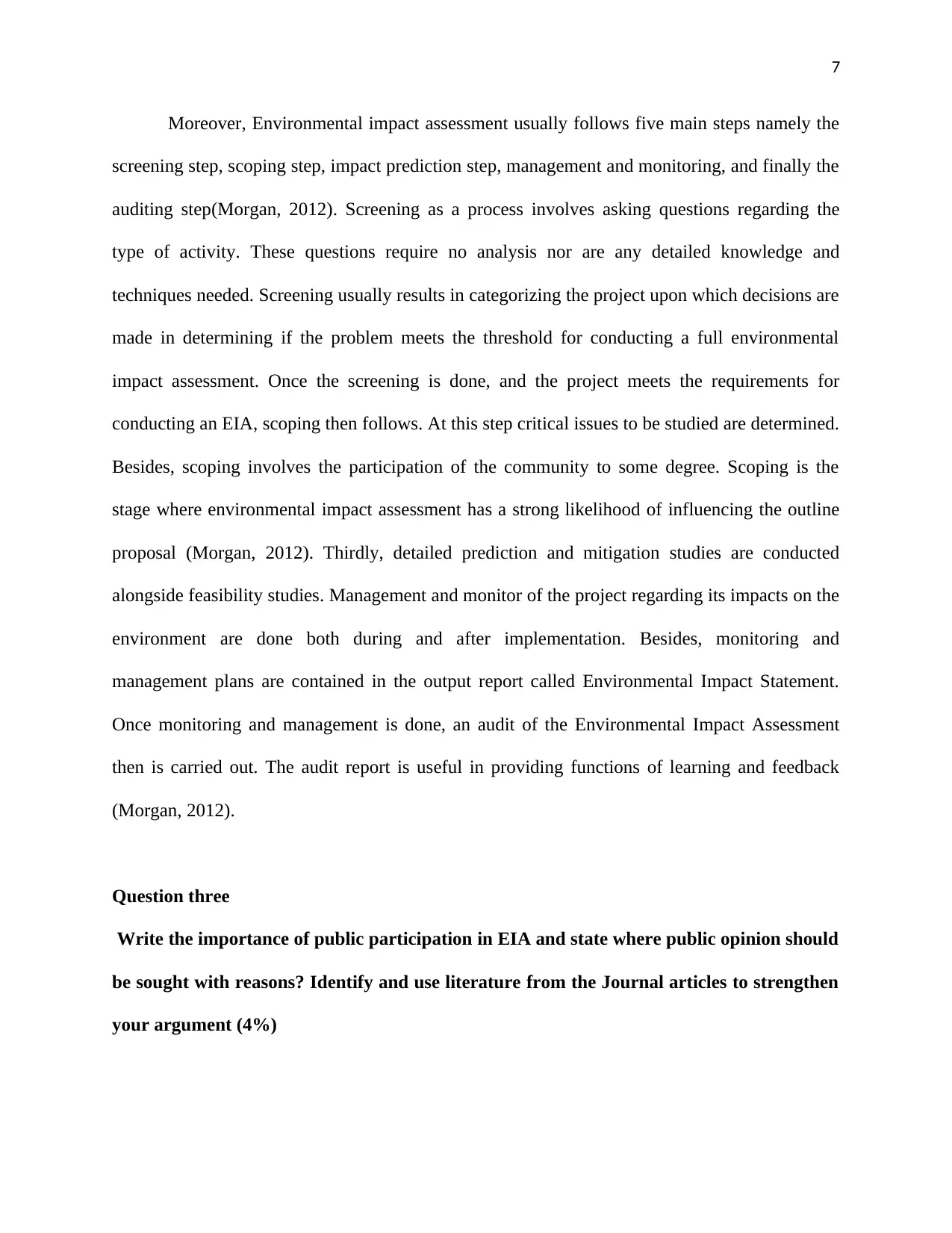
7
Moreover, Environmental impact assessment usually follows five main steps namely the
screening step, scoping step, impact prediction step, management and monitoring, and finally the
auditing step(Morgan, 2012). Screening as a process involves asking questions regarding the
type of activity. These questions require no analysis nor are any detailed knowledge and
techniques needed. Screening usually results in categorizing the project upon which decisions are
made in determining if the problem meets the threshold for conducting a full environmental
impact assessment. Once the screening is done, and the project meets the requirements for
conducting an EIA, scoping then follows. At this step critical issues to be studied are determined.
Besides, scoping involves the participation of the community to some degree. Scoping is the
stage where environmental impact assessment has a strong likelihood of influencing the outline
proposal (Morgan, 2012). Thirdly, detailed prediction and mitigation studies are conducted
alongside feasibility studies. Management and monitor of the project regarding its impacts on the
environment are done both during and after implementation. Besides, monitoring and
management plans are contained in the output report called Environmental Impact Statement.
Once monitoring and management is done, an audit of the Environmental Impact Assessment
then is carried out. The audit report is useful in providing functions of learning and feedback
(Morgan, 2012).
Question three
Write the importance of public participation in EIA and state where public opinion should
be sought with reasons? Identify and use literature from the Journal articles to strengthen
your argument (4%)
Moreover, Environmental impact assessment usually follows five main steps namely the
screening step, scoping step, impact prediction step, management and monitoring, and finally the
auditing step(Morgan, 2012). Screening as a process involves asking questions regarding the
type of activity. These questions require no analysis nor are any detailed knowledge and
techniques needed. Screening usually results in categorizing the project upon which decisions are
made in determining if the problem meets the threshold for conducting a full environmental
impact assessment. Once the screening is done, and the project meets the requirements for
conducting an EIA, scoping then follows. At this step critical issues to be studied are determined.
Besides, scoping involves the participation of the community to some degree. Scoping is the
stage where environmental impact assessment has a strong likelihood of influencing the outline
proposal (Morgan, 2012). Thirdly, detailed prediction and mitigation studies are conducted
alongside feasibility studies. Management and monitor of the project regarding its impacts on the
environment are done both during and after implementation. Besides, monitoring and
management plans are contained in the output report called Environmental Impact Statement.
Once monitoring and management is done, an audit of the Environmental Impact Assessment
then is carried out. The audit report is useful in providing functions of learning and feedback
(Morgan, 2012).
Question three
Write the importance of public participation in EIA and state where public opinion should
be sought with reasons? Identify and use literature from the Journal articles to strengthen
your argument (4%)
Paraphrase This Document
Need a fresh take? Get an instant paraphrase of this document with our AI Paraphraser

8
Practically states in Australia are compelled to publish Environmental Impacts Assessment
report to the public (O'Faircheallaigh, 2010). In this regard, the public is allowed to acquit
themselves with the information and give their opinion thus ensuring public participation. Public
participation is significant for environmental assessments for several reasons. The public
provides relevant information and data necessary for assessing the impacts of the environmental
activity on the social and physical environment. According to O'Faircheallaigh (2010), public
participation reduces the likelihood of contentious issues through their identification from public
comments as well as helping the identification of specialized experts.
Additionally, the participation of the public promotes the confidence of the people in the process
of Environmental Impacts Assessment by identifying regional and state issues. Besides, the
involvement of the public improves how the agency understands the problems of conservation
promoting the continuation of knowledge. Also, the participation enhances the quality of the
environmental decisions being made as well as improving the understanding of the community
on issues of conservation and responsible outcomes of protection. Public participation takes
place during the scoping step. At this stage, most the environmental assessments are done
including the incorporation of the community to hear their comments and opinion
(O'Faircheallaigh, 2010).
Involving the public in decision making necessary when the project prioritizes the following
concept. When there is a need to instill acceptance of the project. public participation in the
decision making legitimizes resources spending and energy for EIA. According to Enríquez-de-
Salamanca (2018), even though public assistance does not guarantee acceptance, proponents and
opponents of public participation in projects assert that it boosts recognition. There cases where
civil cooperation has improved project acceptance. There are however cases where the
conflicting results have been found particularly when the system prevents substantive
engagement (Song et al. (2018). Public opinion must also be sought in EIA where it is the public
policy. According to public policies and attitude are interlinking. Public participation in EIA
projects does not only lead to the acceptance of the plans by the stakeholders but also recognition
of the broader policy
Practically states in Australia are compelled to publish Environmental Impacts Assessment
report to the public (O'Faircheallaigh, 2010). In this regard, the public is allowed to acquit
themselves with the information and give their opinion thus ensuring public participation. Public
participation is significant for environmental assessments for several reasons. The public
provides relevant information and data necessary for assessing the impacts of the environmental
activity on the social and physical environment. According to O'Faircheallaigh (2010), public
participation reduces the likelihood of contentious issues through their identification from public
comments as well as helping the identification of specialized experts.
Additionally, the participation of the public promotes the confidence of the people in the process
of Environmental Impacts Assessment by identifying regional and state issues. Besides, the
involvement of the public improves how the agency understands the problems of conservation
promoting the continuation of knowledge. Also, the participation enhances the quality of the
environmental decisions being made as well as improving the understanding of the community
on issues of conservation and responsible outcomes of protection. Public participation takes
place during the scoping step. At this stage, most the environmental assessments are done
including the incorporation of the community to hear their comments and opinion
(O'Faircheallaigh, 2010).
Involving the public in decision making necessary when the project prioritizes the following
concept. When there is a need to instill acceptance of the project. public participation in the
decision making legitimizes resources spending and energy for EIA. According to Enríquez-de-
Salamanca (2018), even though public assistance does not guarantee acceptance, proponents and
opponents of public participation in projects assert that it boosts recognition. There cases where
civil cooperation has improved project acceptance. There are however cases where the
conflicting results have been found particularly when the system prevents substantive
engagement (Song et al. (2018). Public opinion must also be sought in EIA where it is the public
policy. According to public policies and attitude are interlinking. Public participation in EIA
projects does not only lead to the acceptance of the plans by the stakeholders but also recognition
of the broader policy

9
Question Four
Consider a development activity in a square kilometer area (pick up any site using Google
map, except the one used in the workshop) within Australia and conduct an environmental
impact assessment. Your EIA should include all the steps taught in the class. Every step
will be marked equally. (15%)
Industrial activities have several impacts on the environment which if not adequately
checked may limit natural resources sooner than expected (Thomas, 2001). Profit maximization
compels these industries to focus on the income generation than sustainable exploitation of
resources. Taking the site of Stuart Petroleum Limited as the development site, the environment
impact assessment then follows. Stuart Petroleum Limited is operating in the Cooper Basin and
found at Panning Block South Australia. Besides, the company specialized in development,
production, and exploration of oil, coal, and gas. The company is headquartered along 22King
William Street Adelaide, Australia. The study, therefore, does an environmental assessment on
the impact of Stuart activities on the environment (STU, 2011).
Since the screening is already stated, defining the scope and outlining the investigation of the
impacts of the Stuart Petroleum industry on the natural environment then follow. At this step, the
essential items necessary for the study are identified. The aim of this study, therefore, is to
identify the issue of concern brought about by activities of Stuart petroleum. Besides, it aims at
promoting public participating in conserving the environment around Adelaide. Furthermore,
critical stakeholders like the federal and territorial governments as well as individuals who are
interested are involved (STU, 2011).
Question Four
Consider a development activity in a square kilometer area (pick up any site using Google
map, except the one used in the workshop) within Australia and conduct an environmental
impact assessment. Your EIA should include all the steps taught in the class. Every step
will be marked equally. (15%)
Industrial activities have several impacts on the environment which if not adequately
checked may limit natural resources sooner than expected (Thomas, 2001). Profit maximization
compels these industries to focus on the income generation than sustainable exploitation of
resources. Taking the site of Stuart Petroleum Limited as the development site, the environment
impact assessment then follows. Stuart Petroleum Limited is operating in the Cooper Basin and
found at Panning Block South Australia. Besides, the company specialized in development,
production, and exploration of oil, coal, and gas. The company is headquartered along 22King
William Street Adelaide, Australia. The study, therefore, does an environmental assessment on
the impact of Stuart activities on the environment (STU, 2011).
Since the screening is already stated, defining the scope and outlining the investigation of the
impacts of the Stuart Petroleum industry on the natural environment then follow. At this step, the
essential items necessary for the study are identified. The aim of this study, therefore, is to
identify the issue of concern brought about by activities of Stuart petroleum. Besides, it aims at
promoting public participating in conserving the environment around Adelaide. Furthermore,
critical stakeholders like the federal and territorial governments as well as individuals who are
interested are involved (STU, 2011).

10
Since the scope is already established, prediction and mitigation measures are carried out. The
prediction is made regarding the impact of the project on the operations of the industry and the
ecosystem (Thomas, 2001). Besides, the weakest systemic links of oil and gas exploration and
how they stress the environment as well as biodiversity is conducted. Once these links and
impacts are predicted, their management and monitor will thereafter be carried out in order to
reduce the likelihood of bias among stakeholders (Thomas, 2001). A comprehensive audit will,
therefore, conclude the study on the successes and failures of the project outlining the best way
to strike a balance between the operations of the industry and environment for sustainable
resource exploitation by Stuart Petroleum Company.
Question Five
Soft tools are essential in changing the behavior of the public. Design a strategy (especially
one or more soft tools and associated modifications) to control the following behavior of
Reducing carbon emissions from vehicles. Your answer should include research on
strategies adopted in other countries of similar socioeconomic status to the country you are
designing the strategy. (7%)
According to Ameen, Mourshed, and Li (2015), there is a rapid growth of urban centers across
the globe. Statistically, urban centers contain approximately 50% of the total population in the
world. Furthermore, future projection indicates that this figure may rise to 69% by 2050 (Ameen,
Mourshed & Li, 2015). Already, the existing cities contribute a lot in depletion of agricultural
lands and natural resources. Precisely, the cities contribute more than 70% of global pollution in
the form of emissions from vehicles and exhausts of industries and power plants. Besides, fossil
fuels are burnt to provide the energy required for these processes. With the likelihood of
increased dependence on energy in these cities, the environment stands a chance of more
Since the scope is already established, prediction and mitigation measures are carried out. The
prediction is made regarding the impact of the project on the operations of the industry and the
ecosystem (Thomas, 2001). Besides, the weakest systemic links of oil and gas exploration and
how they stress the environment as well as biodiversity is conducted. Once these links and
impacts are predicted, their management and monitor will thereafter be carried out in order to
reduce the likelihood of bias among stakeholders (Thomas, 2001). A comprehensive audit will,
therefore, conclude the study on the successes and failures of the project outlining the best way
to strike a balance between the operations of the industry and environment for sustainable
resource exploitation by Stuart Petroleum Company.
Question Five
Soft tools are essential in changing the behavior of the public. Design a strategy (especially
one or more soft tools and associated modifications) to control the following behavior of
Reducing carbon emissions from vehicles. Your answer should include research on
strategies adopted in other countries of similar socioeconomic status to the country you are
designing the strategy. (7%)
According to Ameen, Mourshed, and Li (2015), there is a rapid growth of urban centers across
the globe. Statistically, urban centers contain approximately 50% of the total population in the
world. Furthermore, future projection indicates that this figure may rise to 69% by 2050 (Ameen,
Mourshed & Li, 2015). Already, the existing cities contribute a lot in depletion of agricultural
lands and natural resources. Precisely, the cities contribute more than 70% of global pollution in
the form of emissions from vehicles and exhausts of industries and power plants. Besides, fossil
fuels are burnt to provide the energy required for these processes. With the likelihood of
increased dependence on energy in these cities, the environment stands a chance of more
Secure Best Marks with AI Grader
Need help grading? Try our AI Grader for instant feedback on your assignments.
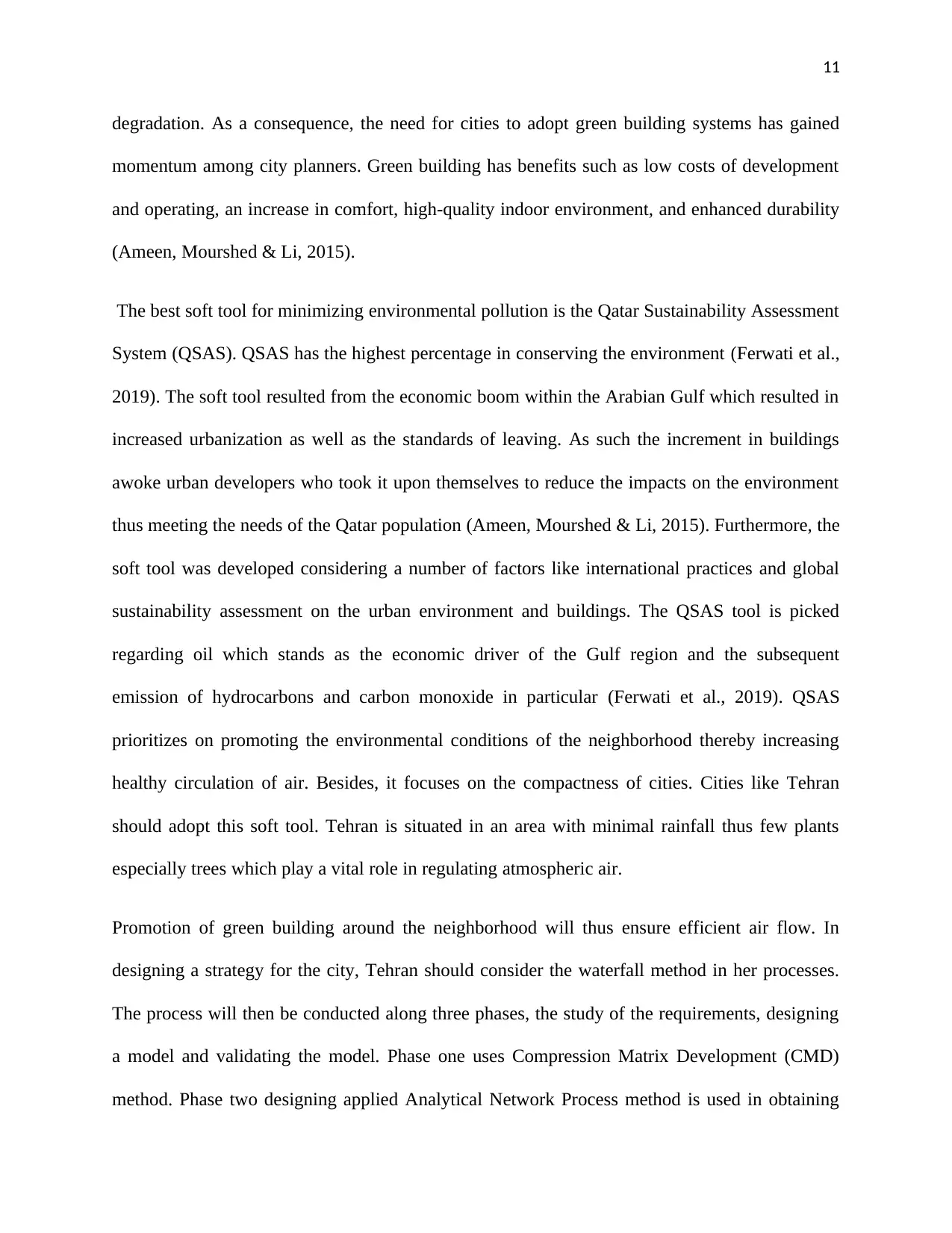
11
degradation. As a consequence, the need for cities to adopt green building systems has gained
momentum among city planners. Green building has benefits such as low costs of development
and operating, an increase in comfort, high-quality indoor environment, and enhanced durability
(Ameen, Mourshed & Li, 2015).
The best soft tool for minimizing environmental pollution is the Qatar Sustainability Assessment
System (QSAS). QSAS has the highest percentage in conserving the environment (Ferwati et al.,
2019). The soft tool resulted from the economic boom within the Arabian Gulf which resulted in
increased urbanization as well as the standards of leaving. As such the increment in buildings
awoke urban developers who took it upon themselves to reduce the impacts on the environment
thus meeting the needs of the Qatar population (Ameen, Mourshed & Li, 2015). Furthermore, the
soft tool was developed considering a number of factors like international practices and global
sustainability assessment on the urban environment and buildings. The QSAS tool is picked
regarding oil which stands as the economic driver of the Gulf region and the subsequent
emission of hydrocarbons and carbon monoxide in particular (Ferwati et al., 2019). QSAS
prioritizes on promoting the environmental conditions of the neighborhood thereby increasing
healthy circulation of air. Besides, it focuses on the compactness of cities. Cities like Tehran
should adopt this soft tool. Tehran is situated in an area with minimal rainfall thus few plants
especially trees which play a vital role in regulating atmospheric air.
Promotion of green building around the neighborhood will thus ensure efficient air flow. In
designing a strategy for the city, Tehran should consider the waterfall method in her processes.
The process will then be conducted along three phases, the study of the requirements, designing
a model and validating the model. Phase one uses Compression Matrix Development (CMD)
method. Phase two designing applied Analytical Network Process method is used in obtaining
degradation. As a consequence, the need for cities to adopt green building systems has gained
momentum among city planners. Green building has benefits such as low costs of development
and operating, an increase in comfort, high-quality indoor environment, and enhanced durability
(Ameen, Mourshed & Li, 2015).
The best soft tool for minimizing environmental pollution is the Qatar Sustainability Assessment
System (QSAS). QSAS has the highest percentage in conserving the environment (Ferwati et al.,
2019). The soft tool resulted from the economic boom within the Arabian Gulf which resulted in
increased urbanization as well as the standards of leaving. As such the increment in buildings
awoke urban developers who took it upon themselves to reduce the impacts on the environment
thus meeting the needs of the Qatar population (Ameen, Mourshed & Li, 2015). Furthermore, the
soft tool was developed considering a number of factors like international practices and global
sustainability assessment on the urban environment and buildings. The QSAS tool is picked
regarding oil which stands as the economic driver of the Gulf region and the subsequent
emission of hydrocarbons and carbon monoxide in particular (Ferwati et al., 2019). QSAS
prioritizes on promoting the environmental conditions of the neighborhood thereby increasing
healthy circulation of air. Besides, it focuses on the compactness of cities. Cities like Tehran
should adopt this soft tool. Tehran is situated in an area with minimal rainfall thus few plants
especially trees which play a vital role in regulating atmospheric air.
Promotion of green building around the neighborhood will thus ensure efficient air flow. In
designing a strategy for the city, Tehran should consider the waterfall method in her processes.
The process will then be conducted along three phases, the study of the requirements, designing
a model and validating the model. Phase one uses Compression Matrix Development (CMD)
method. Phase two designing applied Analytical Network Process method is used in obtaining

12
the weights of criteria. At this phase, compactness is analyzed ensuring that highest limited
valued is attained followed by urban connectivity. Besides, the design should include improving
transportation and diversity (Ferwati et al., 2019). This will achieve best results if fully
implemented by any city with the desire to promote sustainable emissions of oxides of carbon.
the weights of criteria. At this phase, compactness is analyzed ensuring that highest limited
valued is attained followed by urban connectivity. Besides, the design should include improving
transportation and diversity (Ferwati et al., 2019). This will achieve best results if fully
implemented by any city with the desire to promote sustainable emissions of oxides of carbon.
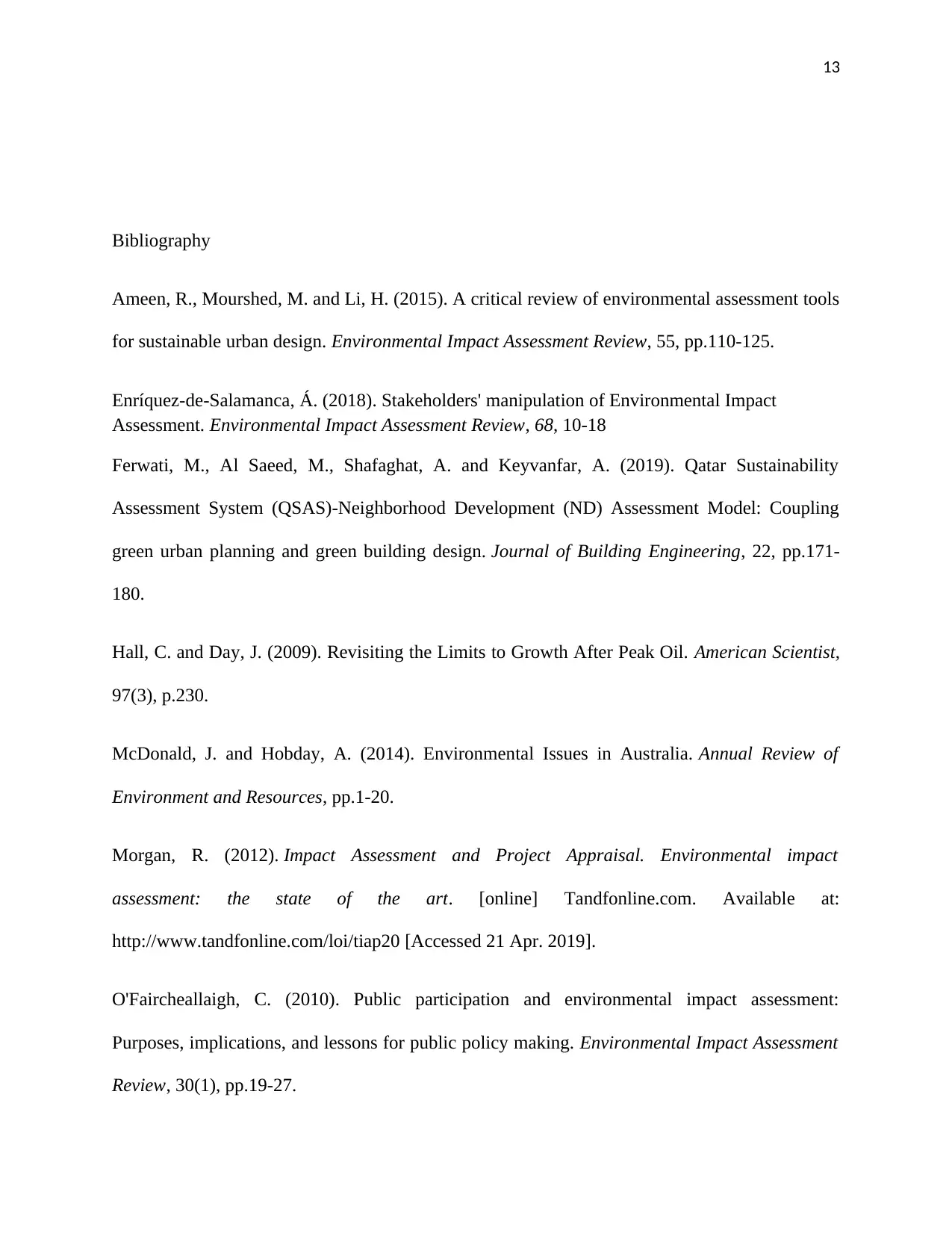
13
Bibliography
Ameen, R., Mourshed, M. and Li, H. (2015). A critical review of environmental assessment tools
for sustainable urban design. Environmental Impact Assessment Review, 55, pp.110-125.
Enríquez-de-Salamanca, Á. (2018). Stakeholders' manipulation of Environmental Impact
Assessment. Environmental Impact Assessment Review, 68, 10-18
Ferwati, M., Al Saeed, M., Shafaghat, A. and Keyvanfar, A. (2019). Qatar Sustainability
Assessment System (QSAS)-Neighborhood Development (ND) Assessment Model: Coupling
green urban planning and green building design. Journal of Building Engineering, 22, pp.171-
180.
Hall, C. and Day, J. (2009). Revisiting the Limits to Growth After Peak Oil. American Scientist,
97(3), p.230.
McDonald, J. and Hobday, A. (2014). Environmental Issues in Australia. Annual Review of
Environment and Resources, pp.1-20.
Morgan, R. (2012). Impact Assessment and Project Appraisal. Environmental impact
assessment: the state of the art. [online] Tandfonline.com. Available at:
http://www.tandfonline.com/loi/tiap20 [Accessed 21 Apr. 2019].
O'Faircheallaigh, C. (2010). Public participation and environmental impact assessment:
Purposes, implications, and lessons for public policy making. Environmental Impact Assessment
Review, 30(1), pp.19-27.
Bibliography
Ameen, R., Mourshed, M. and Li, H. (2015). A critical review of environmental assessment tools
for sustainable urban design. Environmental Impact Assessment Review, 55, pp.110-125.
Enríquez-de-Salamanca, Á. (2018). Stakeholders' manipulation of Environmental Impact
Assessment. Environmental Impact Assessment Review, 68, 10-18
Ferwati, M., Al Saeed, M., Shafaghat, A. and Keyvanfar, A. (2019). Qatar Sustainability
Assessment System (QSAS)-Neighborhood Development (ND) Assessment Model: Coupling
green urban planning and green building design. Journal of Building Engineering, 22, pp.171-
180.
Hall, C. and Day, J. (2009). Revisiting the Limits to Growth After Peak Oil. American Scientist,
97(3), p.230.
McDonald, J. and Hobday, A. (2014). Environmental Issues in Australia. Annual Review of
Environment and Resources, pp.1-20.
Morgan, R. (2012). Impact Assessment and Project Appraisal. Environmental impact
assessment: the state of the art. [online] Tandfonline.com. Available at:
http://www.tandfonline.com/loi/tiap20 [Accessed 21 Apr. 2019].
O'Faircheallaigh, C. (2010). Public participation and environmental impact assessment:
Purposes, implications, and lessons for public policy making. Environmental Impact Assessment
Review, 30(1), pp.19-27.
Paraphrase This Document
Need a fresh take? Get an instant paraphrase of this document with our AI Paraphraser
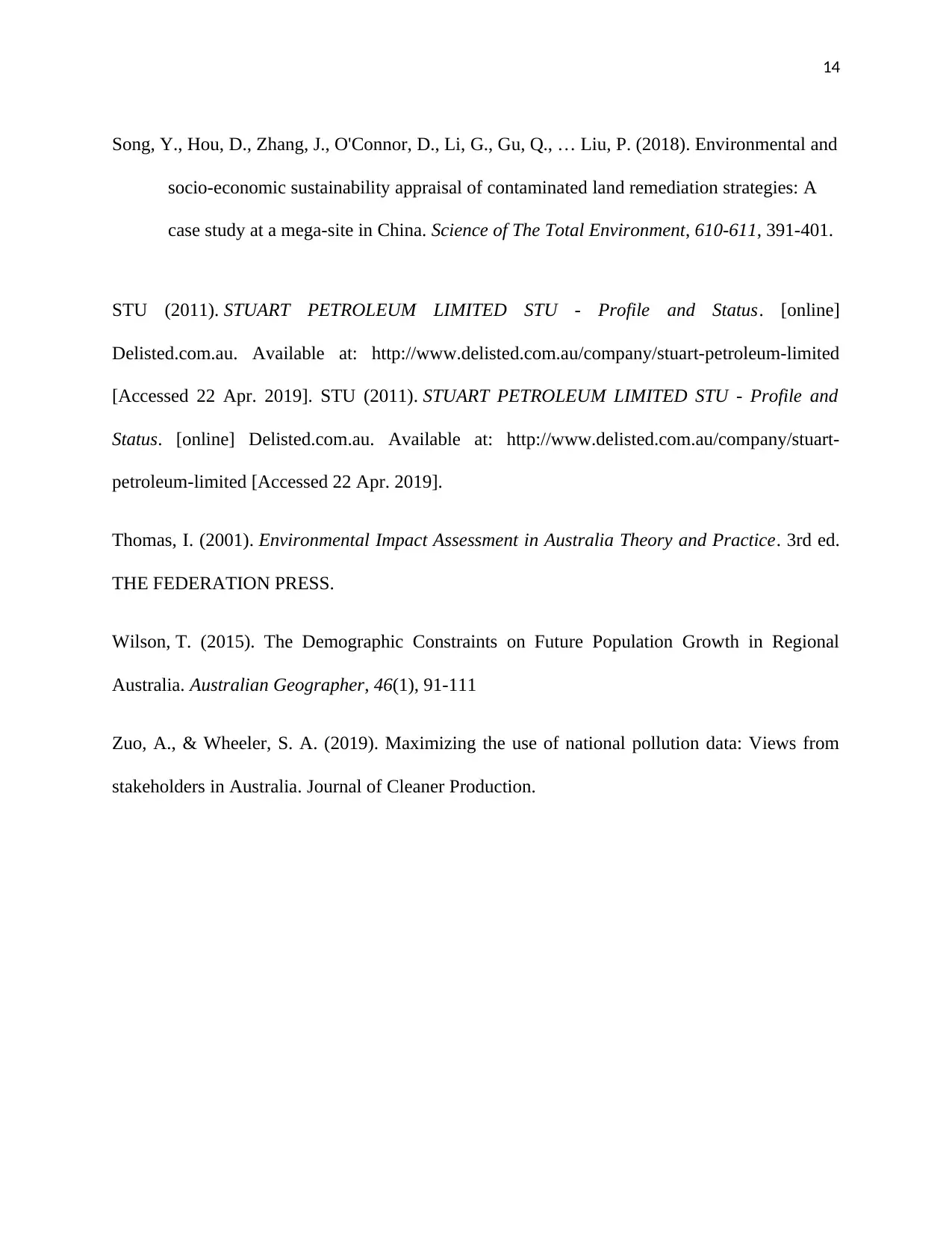
14
Song, Y., Hou, D., Zhang, J., O'Connor, D., Li, G., Gu, Q., … Liu, P. (2018). Environmental and
socio-economic sustainability appraisal of contaminated land remediation strategies: A
case study at a mega-site in China. Science of The Total Environment, 610-611, 391-401.
STU (2011). STUART PETROLEUM LIMITED STU - Profile and Status. [online]
Delisted.com.au. Available at: http://www.delisted.com.au/company/stuart-petroleum-limited
[Accessed 22 Apr. 2019]. STU (2011). STUART PETROLEUM LIMITED STU - Profile and
Status. [online] Delisted.com.au. Available at: http://www.delisted.com.au/company/stuart-
petroleum-limited [Accessed 22 Apr. 2019].
Thomas, I. (2001). Environmental Impact Assessment in Australia Theory and Practice. 3rd ed.
THE FEDERATION PRESS.
Wilson, T. (2015). The Demographic Constraints on Future Population Growth in Regional
Australia. Australian Geographer, 46(1), 91-111
Zuo, A., & Wheeler, S. A. (2019). Maximizing the use of national pollution data: Views from
stakeholders in Australia. Journal of Cleaner Production.
Song, Y., Hou, D., Zhang, J., O'Connor, D., Li, G., Gu, Q., … Liu, P. (2018). Environmental and
socio-economic sustainability appraisal of contaminated land remediation strategies: A
case study at a mega-site in China. Science of The Total Environment, 610-611, 391-401.
STU (2011). STUART PETROLEUM LIMITED STU - Profile and Status. [online]
Delisted.com.au. Available at: http://www.delisted.com.au/company/stuart-petroleum-limited
[Accessed 22 Apr. 2019]. STU (2011). STUART PETROLEUM LIMITED STU - Profile and
Status. [online] Delisted.com.au. Available at: http://www.delisted.com.au/company/stuart-
petroleum-limited [Accessed 22 Apr. 2019].
Thomas, I. (2001). Environmental Impact Assessment in Australia Theory and Practice. 3rd ed.
THE FEDERATION PRESS.
Wilson, T. (2015). The Demographic Constraints on Future Population Growth in Regional
Australia. Australian Geographer, 46(1), 91-111
Zuo, A., & Wheeler, S. A. (2019). Maximizing the use of national pollution data: Views from
stakeholders in Australia. Journal of Cleaner Production.
1 out of 14
Related Documents
Your All-in-One AI-Powered Toolkit for Academic Success.
+13062052269
info@desklib.com
Available 24*7 on WhatsApp / Email
![[object Object]](/_next/static/media/star-bottom.7253800d.svg)
Unlock your academic potential
© 2024 | Zucol Services PVT LTD | All rights reserved.





